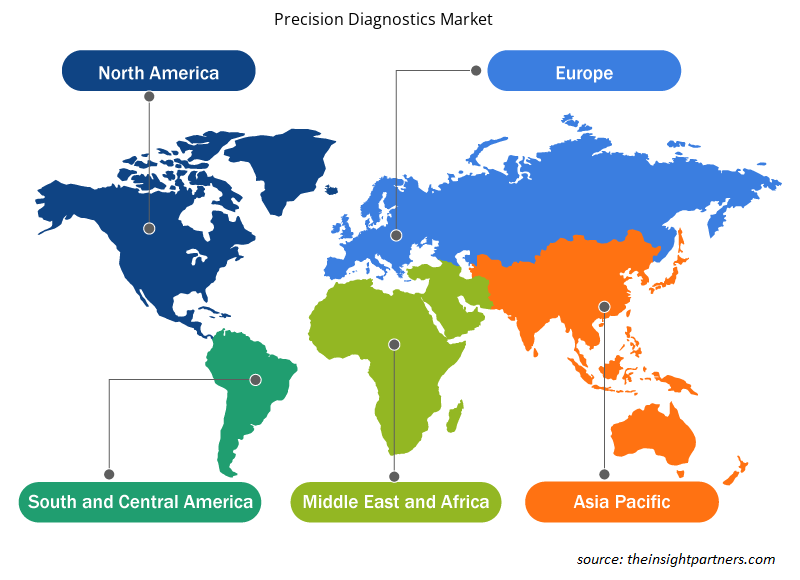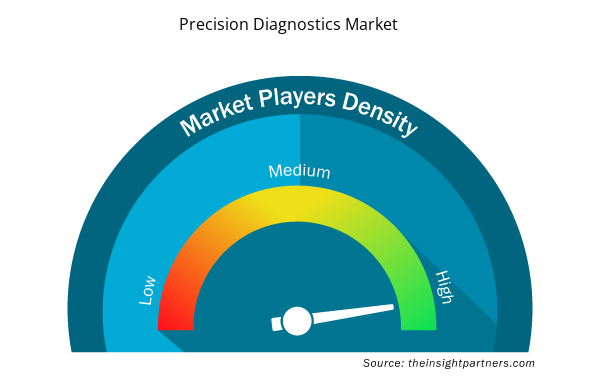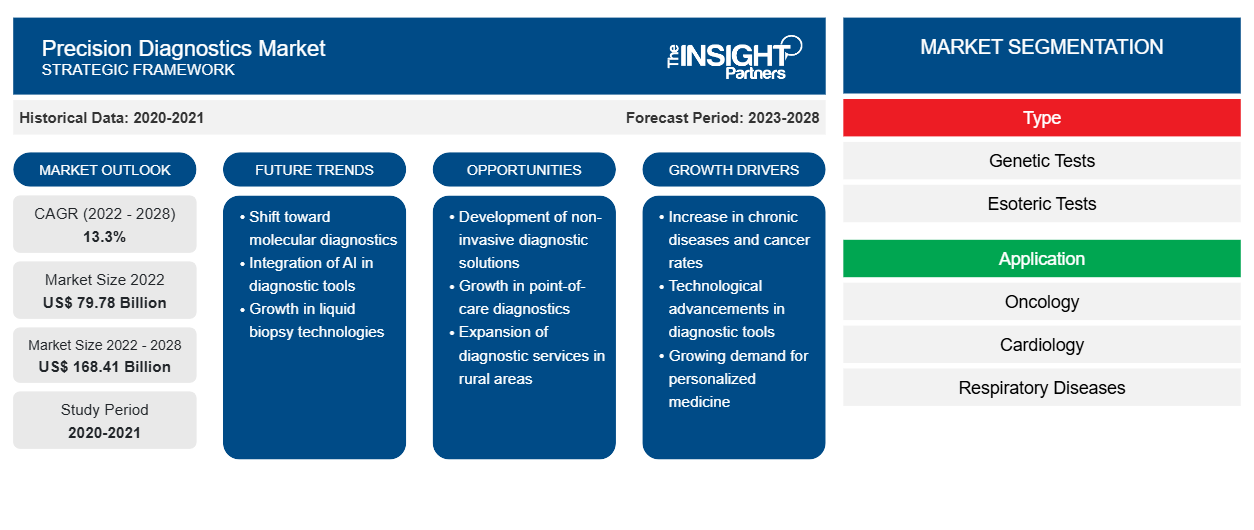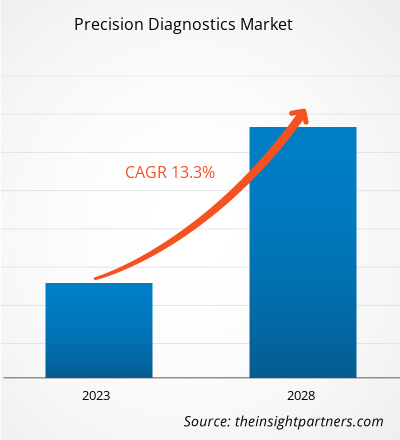[Informe de investigación] Se proyecta que el mercado de diagnóstico de precisión alcance los US$ 168.405,71 millones para 2028 desde los US$ 79.776,88 millones en 2022; se espera que crezca a una CAGR del 13,3% entre 2022 y 2028.
Los diagnósticos de precisión son métodos de diagnóstico de enfermedades que explican el estado del paciente de forma detallada y precisa. Ayudan a los profesionales sanitarios a llevar a cabo los procedimientos de tratamiento de forma eficaz y eficiente. Se utilizan para curar la diabetes, el cáncer y otros trastornos mediante diversas pruebas, incluidas las pruebas esotéricas, las pruebas genéticas y otras.
El mercado de diagnóstico de precisión está segmentado en función del tipo, la aplicación, el usuario final y la geografía. Por geografía, el mercado está segmentado en América del Norte, Europa, Asia Pacífico, Oriente Medio y África, y SAM. El informe de mercado de diagnóstico de precisión ofrece información y un análisis profundo del mercado, haciendo hincapié en parámetros como el tamaño del mercado, las tendencias, los avances tecnológicos y la dinámica del mercado. También proporciona el análisis del panorama competitivo de los principales actores del mercado en todo el mundo. Además, el informe incluye el impacto de la pandemia de COVID-19 en el mercado de diagnóstico de precisión en todas las regiones.
Personalice este informe según sus necesidades
Obtendrá personalización en cualquier informe, sin cargo, incluidas partes de este informe o análisis a nivel de país, paquete de datos de Excel, así como también grandes ofertas y descuentos para empresas emergentes y universidades.
- Obtenga las principales tendencias clave del mercado de este informe.Esta muestra GRATUITA incluirá análisis de datos, desde tendencias del mercado hasta estimaciones y pronósticos.
El crecimiento del mercado de diagnósticos de precisión se atribuye al creciente número de estudios en desarrollo de nuevos tratamientos contra el cáncer y a las iniciativas gubernamentales para crear conciencia sobre los diagnósticos de precisión entre los trabajadores de la salud de la comunidad. Sin embargo, el alto costo asociado con el diagnóstico y la medicina de precisión restringe el crecimiento del mercado.
Perspectivas de mercado
La creciente aplicación en oncología y otros trastornos impulsa el crecimiento del mercado de diagnósticos de precisión
El concepto de medicina de precisión se está aplicando con fuerza en el tratamiento de enfermedades raras. Aunque es más popular en oncología , se está extendiendo gradualmente a otras especialidades. La creciente prevalencia del cáncer y la creciente incidencia de trastornos neurológicos raros están aumentando la demanda de medicina de precisión, lo que está impulsando el crecimiento del mercado mundial de diagnósticos de precisión. Además, según la Neurological Alliance, en 2019 se registraron alrededor de 14,7 millones de casos neurológicos, y al menos 1 de cada 6 personas padece una o más afecciones neurológicas. Según el Instituto Nacional del Cáncer, se prevé que el número de nuevos casos de cáncer aumente a 29,5 millones para 2040, y las muertes relacionadas con el cáncer aumenten en 16,4 millones. Según la Organización Mundial de la Salud (OMS), la enfermedad de Alzheimer, la forma más común de demencia, contribuye a casi el 60-70% de los casos. Además, a septiembre de 2021, más de 55 millones de personas viven con demencia en todo el mundo, lo que representa casi 10 millones de nuevos casos al año. Además, la creciente demanda de procedimientos de tratamiento en oncología y otros trastornos está impulsando la adopción de procedimientos de tratamiento.
Además, el creciente número de colaboraciones estratégicas entre empresas biofarmacéuticas para desarrollar medicamentos destinados a tratar a un grupo específico de pacientes en función de sus necesidades específicas y proporcionar procedimientos y servicios de tratamiento eficaces está aumentando el número de ensayos clínicos. Por ejemplo, Personal Genome Diagnostics Inc. y el Hospital General de Massachusetts colaboraron para avanzar en el desarrollo de servicios de tratamiento eficaces en 2021. En abril de 2022, se forma el Precision Cancer Consortium (PCC) como una nueva colaboración de empresas farmacéuticas con una visión compartida de proporcionar pruebas integrales a todos los pacientes con cáncer en todo el mundo. Por lo tanto, la creciente aplicación en oncología y otros trastornos impulsa el crecimiento del mercado de diagnósticos de precisión.
Perspectivas basadas en tipos
Según el tipo, el mercado de diagnóstico de precisión se segmenta en pruebas genéticas, pruebas esotéricas y otras. En 2022, el segmento de pruebas genéticas tiene la mayor participación del mercado. Además, se espera que el mismo segmento registre la CAGR más alta del 13,8 % durante el período de pronóstico.
Perspectivas basadas en aplicaciones
Según la aplicación, el mercado de diagnóstico de precisión se segmenta en oncología, cardiología, enfermedades respiratorias, inmunología y otros. El segmento de oncología tiene la mayor participación de mercado en 2022. Además, se prevé que el mismo segmento registre la CAGR más alta del 13,8 % durante el período de pronóstico.
Información basada en el usuario final
Según el usuario final, el mercado de diagnóstico de precisión se segmenta en laboratorios clínicos, hospitales, atención domiciliaria y otros. El segmento de laboratorios clínicos tiene la mayor participación de mercado en 2022. Además, se prevé que el mismo segmento registre la CAGR más alta del 13,8 % durante el período de pronóstico.
Los actores del mercado de diagnóstico de precisión se centran en adoptar estrategias orgánicas, incluido el lanzamiento y la expansión de productos, para expandir su presencia y cartera de productos en todo el mundo y satisfacer las crecientes demandas.
Plataforma de gestión de eventos
Perspectivas regionales del mercado de diagnóstico de precisión
Los analistas de Insight Partners explicaron en detalle las tendencias y los factores regionales que influyen en el mercado de diagnóstico de precisión durante el período de pronóstico. Esta sección también analiza los segmentos y la geografía del mercado de diagnóstico de precisión en América del Norte, Europa, Asia Pacífico, Oriente Medio y África, y América del Sur y Central.

- Obtenga datos regionales específicos para el mercado de diagnóstico de precisión
Alcance del informe de mercado de diagnóstico de precisión
| Atributo del informe | Detalles |
|---|---|
| Tamaño del mercado en 2022 | US$ 79,78 mil millones |
| Tamaño del mercado en 2028 | US$ 168,41 mil millones |
| CAGR global (2022-2028) | 13,3% |
| Datos históricos | 2020-2021 |
| Período de pronóstico | 2023-2028 |
| Segmentos cubiertos | Por tipo
|
| Regiones y países cubiertos | América del norte
|
| Líderes del mercado y perfiles de empresas clave |
|
Densidad de actores del mercado de diagnóstico de precisión: comprensión de su impacto en la dinámica empresarial
El mercado de diagnóstico de precisión está creciendo rápidamente, impulsado por la creciente demanda de los usuarios finales debido a factores como la evolución de las preferencias de los consumidores, los avances tecnológicos y una mayor conciencia de los beneficios del producto. A medida que aumenta la demanda, las empresas amplían sus ofertas, innovan para satisfacer las necesidades de los consumidores y aprovechan las tendencias emergentes, lo que impulsa aún más el crecimiento del mercado.
La densidad de actores del mercado se refiere a la distribución de las empresas o firmas que operan dentro de un mercado o industria en particular. Indica cuántos competidores (actores del mercado) están presentes en un espacio de mercado determinado en relación con su tamaño o valor total de mercado.
Las principales empresas que operan en el mercado de diagnóstico de precisión son:
- Quest Diagnostics Incorporated
- QIAGEN
- Swiss Precision Diagnostics GmbH
- Philips NV, la línea Koninklijke
- Imágenes médicas Lantheus, Inc.
Descargo de responsabilidad : Las empresas enumeradas anteriormente no están clasificadas en ningún orden particular.

- Obtenga una descripción general de los principales actores clave del mercado de diagnóstico de precisión
Por geografía
Según la geografía, el mercado de diagnóstico de precisión está segmentado en América del Norte (EE. UU., Canadá y México), Europa (Reino Unido, Alemania, Francia, Italia, España y el resto de Europa), Asia Pacífico (China, Japón, India, Australia, Corea del Sur y el resto de Asia Pacífico), Medio Oriente y África (EAU, Arabia Saudita, Sudáfrica y el resto de Medio Oriente y África) y América del Sur y Central (Brasil, Argentina y el resto de América del Sur y Central).
Perfiles de empresas
- Quest Diagnostics Incorporated
- QIAGEN
- Swiss Precision Diagnostics GmbH
- Philips NV, la línea Koninklijke
- Imágenes médicas Lantheus, Inc.
- Siemens Healthineers AG
- Abad
- Novartis AG
- Sanofi
- Bayer AG
- Análisis histórico (2 años), año base, pronóstico (7 años) con CAGR
- Análisis PEST y FODA
- Tamaño del mercado Valor/volumen: global, regional, nacional
- Industria y panorama competitivo
- Conjunto de datos de Excel



Report Coverage
Revenue forecast, Company Analysis, Industry landscape, Growth factors, and Trends

Segment Covered
This text is related
to segments covered.

Regional Scope
North America, Europe, Asia Pacific, Middle East & Africa, South & Central America

Country Scope
This text is related
to country scope.
Preguntas frecuentes
Precision diagnostics are disease diagnosis methods that explain the patient’s condition in a detailed and precise manner. It helps healthcare professionals to carry out treatment procedures in an effective and efficient manner. It is used to cure diabetes, cancer, and other disorders using various diagnostics tests.
The factors that are driving the growth of market are increasing demands of precision medicines and rising application of precision diagnostics. However, high investments involved in the R&D of precision medicine and diagnostic kits is the major factor hindering the precision diagnostics market growth.
The precision diagnostics market majorly consists of the players, such as Quest Diagnostics Incorporated; QIAGEN; Swiss Precision Diagnostics GmbH; Koninklijke Philips N.V.; Lantheus Medical Imaging, Inc.; Siemens Healthineers AG; Abbott; Novartis AG; Sanofi; and Bayer AG.
The market is estimated to grow at a CAGR of 13.3% during the forecast period.
The precision diagnostics market is estimated to be valued at US$ 79,776.88 million in 2022.
The precision diagnostics market is expected to be valued at US$ 168,405.71 million in 2028.
North America accounts for the major market share of precision diagnostics market in 2022 due to increasing prevalence of cancer and chronic cases in the region and increasing initiatives by government and companies operating in the country.
The colorectal cancer market is analyzed in the basis of type, application, and end user. Based on type, the market is segmented into genetic tests, esoteric tests, and others. The genetic tests segment held the largest share of the market. Moreover, the same segment is anticipated to register the highest CAGR in the forecast period.
Asia Pacific is expected to be the fastest growing region in precision diagnostics market over the forecast period due to developing healthcare infrastructure, enormous population base, growing prevalence of chronic diseases, growing government efforts, and technological improvement in the sector.
Trends and growth analysis reports related to Life Sciences : READ MORE..
The List of Companies - Precision Diagnostics Market
- Quest Diagnostics Incorporated
- QIAGEN
- Swiss Precision Diagnostics GmbH
- Koninklijke Philips N.V.
- Lantheus Medical Imaging, Inc.
- Siemens Healthineers AG
- Abbott
- Novartis AG
- Sanofi
- Bayer AG
The Insight Partners performs research in 4 major stages: Data Collection & Secondary Research, Primary Research, Data Analysis and Data Triangulation & Final Review.
- Data Collection and Secondary Research:
As a market research and consulting firm operating from a decade, we have published and advised several client across the globe. First step for any study will start with an assessment of currently available data and insights from existing reports. Further, historical and current market information is collected from Investor Presentations, Annual Reports, SEC Filings, etc., and other information related to company’s performance and market positioning are gathered from Paid Databases (Factiva, Hoovers, and Reuters) and various other publications available in public domain.
Several associations trade associates, technical forums, institutes, societies and organization are accessed to gain technical as well as market related insights through their publications such as research papers, blogs and press releases related to the studies are referred to get cues about the market. Further, white papers, journals, magazines, and other news articles published in last 3 years are scrutinized and analyzed to understand the current market trends.
- Primary Research:
The primarily interview analysis comprise of data obtained from industry participants interview and answers to survey questions gathered by in-house primary team.
For primary research, interviews are conducted with industry experts/CEOs/Marketing Managers/VPs/Subject Matter Experts from both demand and supply side to get a 360-degree view of the market. The primary team conducts several interviews based on the complexity of the markets to understand the various market trends and dynamics which makes research more credible and precise.
A typical research interview fulfils the following functions:
- Provides first-hand information on the market size, market trends, growth trends, competitive landscape, and outlook
- Validates and strengthens in-house secondary research findings
- Develops the analysis team’s expertise and market understanding
Primary research involves email interactions and telephone interviews for each market, category, segment, and sub-segment across geographies. The participants who typically take part in such a process include, but are not limited to:
- Industry participants: VPs, business development managers, market intelligence managers and national sales managers
- Outside experts: Valuation experts, research analysts and key opinion leaders specializing in the electronics and semiconductor industry.
Below is the breakup of our primary respondents by company, designation, and region:

Once we receive the confirmation from primary research sources or primary respondents, we finalize the base year market estimation and forecast the data as per the macroeconomic and microeconomic factors assessed during data collection.
- Data Analysis:
Once data is validated through both secondary as well as primary respondents, we finalize the market estimations by hypothesis formulation and factor analysis at regional and country level.
- Macro-Economic Factor Analysis:
We analyse macroeconomic indicators such the gross domestic product (GDP), increase in the demand for goods and services across industries, technological advancement, regional economic growth, governmental policies, the influence of COVID-19, PEST analysis, and other aspects. This analysis aids in setting benchmarks for various nations/regions and approximating market splits. Additionally, the general trend of the aforementioned components aid in determining the market's development possibilities.
- Country Level Data:
Various factors that are especially aligned to the country are taken into account to determine the market size for a certain area and country, including the presence of vendors, such as headquarters and offices, the country's GDP, demand patterns, and industry growth. To comprehend the market dynamics for the nation, a number of growth variables, inhibitors, application areas, and current market trends are researched. The aforementioned elements aid in determining the country's overall market's growth potential.
- Company Profile:
The “Table of Contents” is formulated by listing and analyzing more than 25 - 30 companies operating in the market ecosystem across geographies. However, we profile only 10 companies as a standard practice in our syndicate reports. These 10 companies comprise leading, emerging, and regional players. Nonetheless, our analysis is not restricted to the 10 listed companies, we also analyze other companies present in the market to develop a holistic view and understand the prevailing trends. The “Company Profiles” section in the report covers key facts, business description, products & services, financial information, SWOT analysis, and key developments. The financial information presented is extracted from the annual reports and official documents of the publicly listed companies. Upon collecting the information for the sections of respective companies, we verify them via various primary sources and then compile the data in respective company profiles. The company level information helps us in deriving the base number as well as in forecasting the market size.
- Developing Base Number:
Aggregation of sales statistics (2020-2022) and macro-economic factor, and other secondary and primary research insights are utilized to arrive at base number and related market shares for 2022. The data gaps are identified in this step and relevant market data is analyzed, collected from paid primary interviews or databases. On finalizing the base year market size, forecasts are developed on the basis of macro-economic, industry and market growth factors and company level analysis.
- Data Triangulation and Final Review:
The market findings and base year market size calculations are validated from supply as well as demand side. Demand side validations are based on macro-economic factor analysis and benchmarks for respective regions and countries. In case of supply side validations, revenues of major companies are estimated (in case not available) based on industry benchmark, approximate number of employees, product portfolio, and primary interviews revenues are gathered. Further revenue from target product/service segment is assessed to avoid overshooting of market statistics. In case of heavy deviations between supply and demand side values, all thes steps are repeated to achieve synchronization.
We follow an iterative model, wherein we share our research findings with Subject Matter Experts (SME’s) and Key Opinion Leaders (KOLs) until consensus view of the market is not formulated – this model negates any drastic deviation in the opinions of experts. Only validated and universally acceptable research findings are quoted in our reports.
We have important check points that we use to validate our research findings – which we call – data triangulation, where we validate the information, we generate from secondary sources with primary interviews and then we re-validate with our internal data bases and Subject matter experts. This comprehensive model enables us to deliver high quality, reliable data in shortest possible time.


 Obtenga una muestra gratuita de este informe
Obtenga una muestra gratuita de este informe